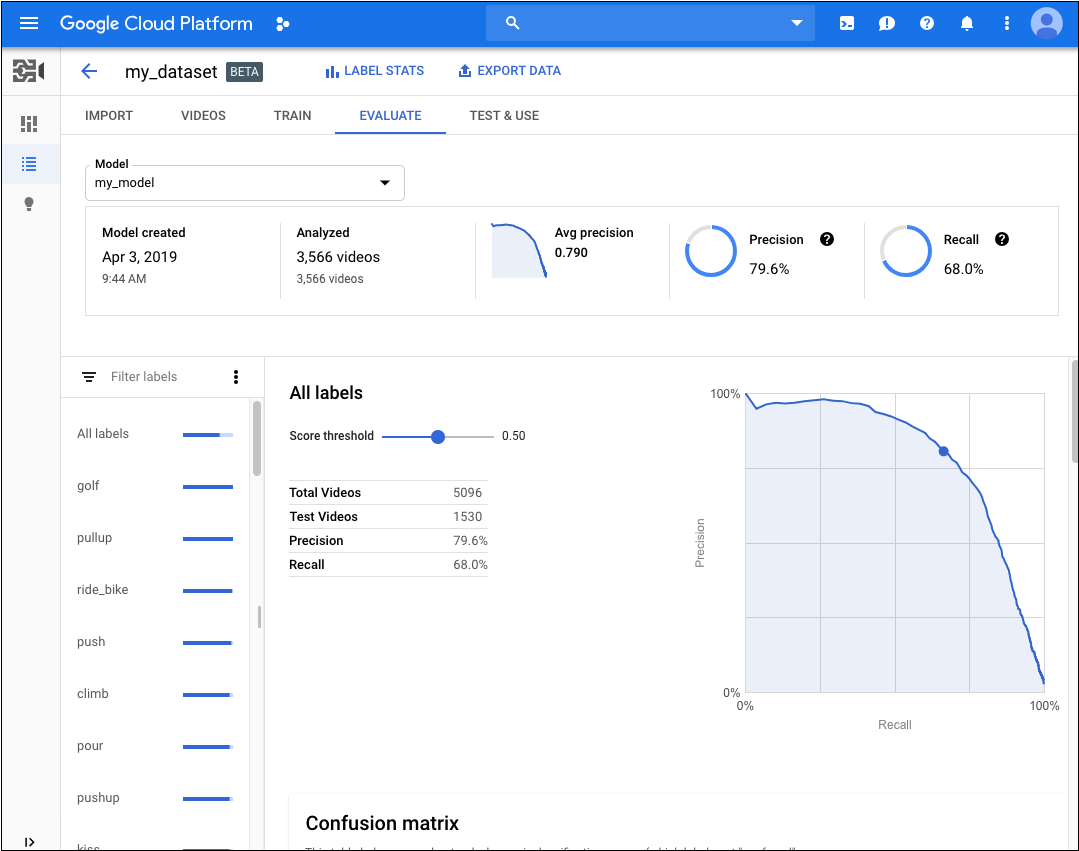Evaluating models
After training a model, AutoML Video Intelligence Classification uses items from the TEST set to evaluate the quality and accuracy of the new model.
AutoML Video Intelligence Classification provides an aggregate set of evaluation metrics indicating how well the model performs overall, as well as evaluation metrics for each category label, indicating how well the model performs for that label.
AuPRC : Area under Precision/Recall curve, also referred to as "average precision." Generally between 0.5 and 1.0. Higher values indicate more accurate models.
The Confidence threshold curves show how different confidence thresholds would affect precision, recall, true and false positive rates. Read about the relationship of precision and recall.
Use this data to evaluate your model's readiness. Low AUC scores, or low precision and recall scores can indicate that your model needs additional training data or has inconsistent labels. A very high AUC score and perfect precision and recall could indicate that the data is too easy and may not generalize well.
Get model evaluation values
Web UI
-
Open the Models page in the AutoML Video UI.
-
Click the row for the model you want to evaluate.
-
Click the Evaluate tab.
If training has completed for the model, AutoML Video shows its evaluation metrics.

- To view metrics for a specific label, select the label name from the list of labels in the lower part of the page.
REST
Before using any of the request data, make the following replacements:
- model-name: the full name of your model, from the response when you created the model. The full name has the format: projects/project-number/locations/location-id/models/model-id.
- project-number: number of your project
HTTP method and URL:
GET https://automl.googleapis.com/v1beta1/model-name:modelEvaluations
To send your request, choose one of these options:
curl
Execute the following command:
curl -X GET \
-H "Authorization: Bearer $(gcloud auth print-access-token)" \
-H "x-goog-user-project: project-number" \
" https://automl.googleapis.com/v1beta1/model-name:modelEvaluations"
PowerShell
Execute the following command:
$cred = gcloud auth print-access-token
$headers = @{ "Authorization" = "Bearer $cred"; "x-goog-user-project" = "project-number" }
Invoke-WebRequest `
-Method GET `
-Headers $headers `
-Uri " https://automl.googleapis.com/v1beta1/model-name:modelEvaluations" | Select-Object -Expand Content
2308399322008336298.
Java
To authenticate to AutoML Video, set up Application Default Credentials. For more information, see Set up authentication for a local development environment.
Node.js
To authenticate to AutoML Video, set up Application Default Credentials. For more information, see Set up authentication for a local development environment.
Python
To authenticate to AutoML Video, set up Application Default Credentials. For more information, see Set up authentication for a local development environment.
Iterate on your model
If you're not happy with the quality levels, you can go back to earlier steps to improve the quality:
- You may need to add different types of videos (e.g. wider angle, higher or lower resolution, different points of view).
- Consider removing labels altogether if you don't have enough training videos.
- Remember that machines can’t read your label name; it's just a random string of letters to them. If you have one label that says "door" and another that says "door_with_knob" the machine has no way of figuring out the nuance other than the videos you provide it.
- Augment your data with more examples of true positives and negatives. Especially important examples are the ones that are close to the decision boundary.
Once you've made changes, train and evaluate a new model until you reach
a high enough quality level.
